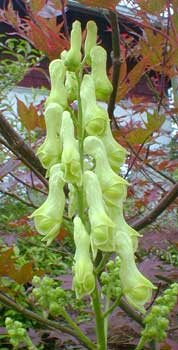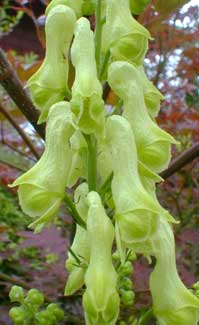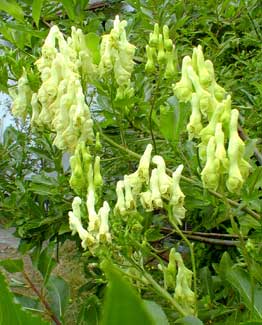
Yellow Monkshood; or,
Northern Wolfsbane; or,
Lamarck's Aconite
"O World, in very truth thou art too young;
When wilt thou learn to wear the garb of age?
World, with thy covering of yellow flowers,
Hast thou forgot what generations sprung
Out of thy loins & loved thee & are gone?"
-Wilfrid Scawen Blunt
(1840-1922)
(1840-1922)
In winter 2002, I obtained this as a gallon pot of soil out of season, with no evidence of the plant's presence. Great way to get cool things inexpensively, if you trust a nursery to not be offloading actually dead stuff.
 Though our collection of monkshoods was already impressive, we didn't have one that bloomed yellow, so it seemed a good idea to add a specimen ofAconite lamarckii (formerly A. ranunculifolium or A. pyrenaicum) to the garden.
Though our collection of monkshoods was already impressive, we didn't have one that bloomed yellow, so it seemed a good idea to add a specimen ofAconite lamarckii (formerly A. ranunculifolium or A. pyrenaicum) to the garden.I planted the pot of dirt in an area underneath our 'Oshio Beni' Japanese maple, where it gets a lot of sun when it first begins to erupt as a short leafy clump in March (because the maple is still without leaves), but by April's end the maple gives it a degree of shade.
For its first spring in our yard, it arrived as quite a healthy clump of deeply cut foliage, but by autumn, it had not bloomed that whole year, so we had to wait until it was over a year settled in the ground before seeing it flower.
The following spring it was again an early-appearing gorgeous clump of large deeply cut maple-like leaves, the clump maturing to two & a half or three feet high & wide. From out of the leafy mound arose flower many branching flower stalks leaping upward to six & seven feet high.
 These extremely tall flower stalks are numerous & showy, but once the buds begin to mature adding weight to the stems, they inevitably fall over, so it needs staking. In gardens larger than ours it can perhaps be given a more open spot where it can flop its flower stems in all directions & look fountaining rather than lodged. We never had to stake ours only because we could tie the huge stems to lower branches of the maple.
These extremely tall flower stalks are numerous & showy, but once the buds begin to mature adding weight to the stems, they inevitably fall over, so it needs staking. In gardens larger than ours it can perhaps be given a more open spot where it can flop its flower stems in all directions & look fountaining rather than lodged. We never had to stake ours only because we could tie the huge stems to lower branches of the maple.In retrospect I didn't select the best location for it, though as far as the plant was concerned, it was a great location, because it thrived & became a bigger clump each year, but also looked floppier & floppier during its very long bloom period. It grew so aggressively it became a threat to nearby perennials I liked a lot better, so I'd clip it to the ground on one side to spare other plants from being crowded, & the monkshood never acted afflicted. In fact no other monkshood in our collection was ever this aggressive.
The yellow-green buds in June are present for quite a long while before they begin to mature into greenish-yellow blossoms in July, with younger buds still coming along so that it will still be blooming well into August.
These blooms are quite a contrast to the usual blue shades of monkshoods, but they are by no means daffodil-bright. They're a subdued yellow-green to a pale cream color as easily taken for off-white or even pale green. I would even assess them as disappointing!
Each helmet-flower on the spikes is taller & narrower than the helmets of blue varieties & bunch up in greater numbers than for most species. An added oddity is how the heads of the stalks bend into crooks while still in bud, but by the time the flowers open they are no longer bent at the top. So it has interesting behaviors.
There overall impact is not as striking as for blue monkshoods of various sorts & they are problably more interesting as oddities for monkshood fans rather than significant in themselves.
A. lamarckii is a native of the Alps & Pyranees. It wants rich humousy soil in a cool area of the garden. If planted in sun it may be somewhat stunted but healthy; in dappled shade the flower stems grow tallest. It is cold-hardy, but can be damaged at the height of summer if it gets too much sun or the soil dries out.
The root will spread in time to two feet wide. Although sometimes it can be divided when old & large, monkshoods in general resent being dug up, & if let be it will not be so apt to "tire" the way aging delphiniums do. By 2008 our clump was gigantic & I would've liked to attempt division & find a different location for it, but this was impossible because it was entwined with the roots of the maple which I wouldn't want to risk damaging.
 The species is named after French physician & botanist Jean Baptiste Pierre Antoine de Monet, Chevalier de Lamarck (1744-1829), whose portrait is at the right. His classic text Flore Francois (Plants of France) was published in 1779. He was even better known as an "invertebrate zoologist," an area of study he pretty much invented, having personally coined the term "invertebrate." His Histoire Naturelle des Animaux Sans Vertebres (Natural History of Animals Without Backbones) was issued in seven volumes from 1815 to 1822.
The species is named after French physician & botanist Jean Baptiste Pierre Antoine de Monet, Chevalier de Lamarck (1744-1829), whose portrait is at the right. His classic text Flore Francois (Plants of France) was published in 1779. He was even better known as an "invertebrate zoologist," an area of study he pretty much invented, having personally coined the term "invertebrate." His Histoire Naturelle des Animaux Sans Vertebres (Natural History of Animals Without Backbones) was issued in seven volumes from 1815 to 1822.Jean-Baptiste Lamark also contributed to areas of meteorology, physics, chemistry, & shell-collecting. He pioneered evolutionary theory, his Philosophie zoologique (1809) anticipating much of Darwin's Descent of Man (1871). In the 1780s he began to contribute signally to the Jardin du Roi (King's Garden), which paid him so little that he lived in penury. In 1793 after Louis XVI & Marie Antoinette went to the guillotine, Lamarck proposed the major reorganization of the Jardin du Roi, which became thereafter the National Museum of Natural History.
Alas, during his lifetime, he never gained the recognition he deserved, chiefly due to the politicization of the natural history museum itself, & because of his daring philosophy of evolution which won him academic enemies.
His position at the Museum was as low man on the totem pole. When he was first appointed "Professor of Worms & Insects," it was an intentional insult, as he had no previous expertise at the time of appointment. Yet he went on to brilliantly define this field of study, carrying on as a true scientist striving to ignore the politics & backstabbing that held him back from greater recognition & monetary rewards.
He died in such penury he could be provided nothing more permanent than a leased grave, from which he was evicted five years later, with no record of what became of his remains thereafter.
In 2009, I finally decided to disinstall the plant. It was so long in the garden, so flower-productive & hardy, that I felt a little guilty never liking it that much, as generally monkshoods are my favorites.
But I'd not planted it in the most advantageous spot; it was each year increasingly threatening to less aggressive perennials; & it was beginning to look a little silly with dozens of flower stalks tied to maple limbs so that they wouldn't fall onto the path.
Since I couldn't dig in that location, I just began yanking at it. Where I got roots, I potted up portions & am presently babying those hoping they recover from the abuse. This by no means did in the clump, which sprang back up big as ever, but I'll keep yanking it out until eventually it's bound to dwindle or tire itself out repeatedly producing leaves & flower stalks.
I do feel cruel about it. It's just a tiny bit like having a "least favorite child" at inducing guilt for liking every other monkshood loads better. But if some of the fragments I tore out & potted turn into healthy plants, I'll feel much better about the cruelty to a productive plant, though I don't think I'll replant the so called "yellow" anywhere in our gardens again, preferring by far a white flowering look-alike for A. lamarckii, namely A. septentrionale 'Ivorine' linked immediately below:
Aconitum septentrionale 'Ivorine'